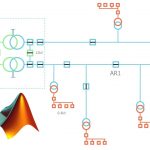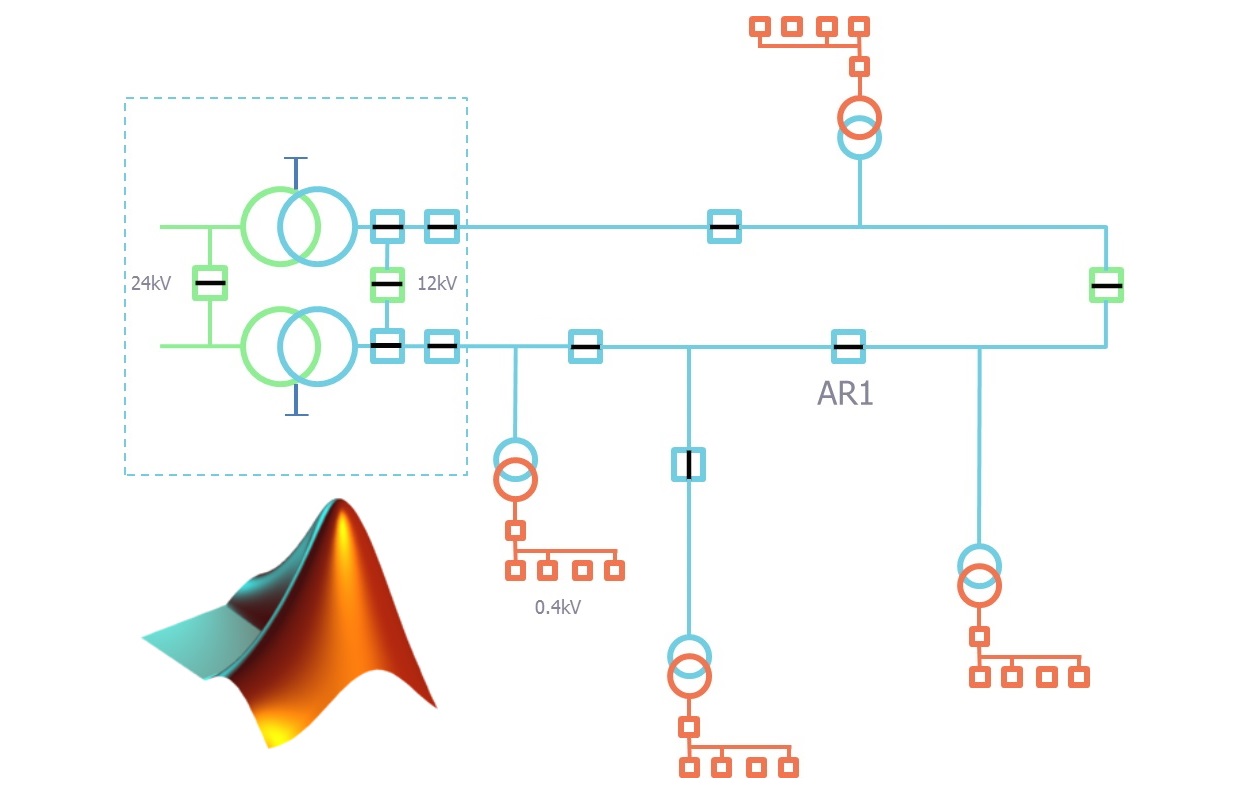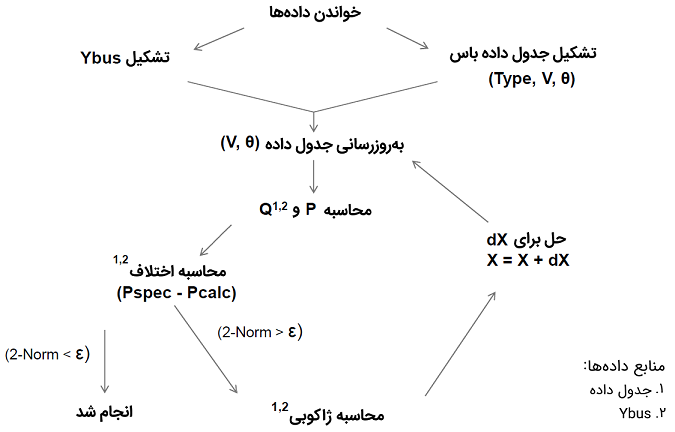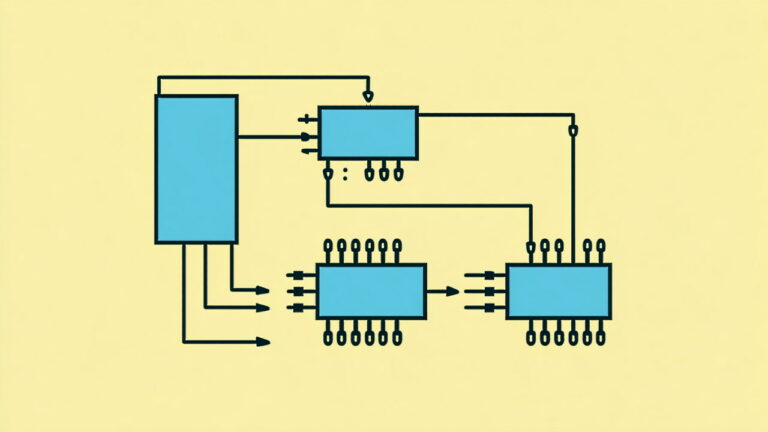پخش بار نیوتن رافسون در متلب – از صفر تا صد
در آموزشهای پیشین مجله فرادرس، با مفاهیم و معادلات پخش بار آشنا شدیم. همچنین روشهای پخش بار نیوتن رافسون و گوس سایدل را به طور مفصل شرح دادیم. در این آموزش، برنامه پخش بار نیوتن رافسون در متلب را ارائه خواهیم کرد.


قبل از بررسی برنامههای متلب، پیشنهاد میکنیم آموزشهای «پخش بار در سیستم قدرت» و «پخش بار نیوتن رافسون» را مطالعه کنید.
در ادامه، خلاصهای از مراحل روش نیوتن رافسون را بیان میکنیم.
خلاصه روش نیوتن رافسون
جریان تزریقی هر باس با فرمول زیر محاسبه میشود:
با استفاده از این جریان، میتوانیم معادلات پخش توانهای اکتیو و راکتیو را بنویسیم:
در نتیجه، با مسئله به فرم مواجه خواهیم بود:
در روش نیوتن رافسون، یک حدس اولیه به صورت زیر داریم:
حدس اولیه
با استفاده از این حدس اولیه، میتوانیم از خطا برای محاسبه یک حدس جدید استفاده کنیم:
مخرج کسر، ژاکوبی است و داریم:
الگوریتم پخش بار نیوتن رافسون به طور خلاصه مطابق شکل زیر است.

برنامه پخش بار نیوتن رافسون در متلب
برنامه اصلی مربوط به پخش بار نیوتن رافسون powerFlow.m است که در ادامه آورده شده است. قبل از اجرای این برنامه مطمئن شوید فایلها و برنامههای زیر در پوشه برنامه باشند:
- فایل BusInputData.csv به عنوان اطلاعات سیستم
- تابع createYbus.m برای تشکیل Ybus از روی فایل اطلاعات BusInputData.csv
- تابع data2bus.m برای ذخیره اطلاعات باس در ساختار جدید برای محاسبات
- تابع findJacob.m برای پیدا کردن ژاکوبی
- تابع sparseAdd.m که در Ybus مورد استفاده قرار میگیرد.
- تابع calcPQ.m که محاسبات P و Q را انجام میدهد.
برنامههای فوق را میتوانید از این لینک [+] دانلود کنید.
درادامه، کد مربوط به هریک از توابع و برنامهها ارائه شده است.
اطلاعات سیستم
فایل ورودی حاوی اطلاعات سیستم BusInputData.csv است که از این لینک [+] قابل دریافت است.
پخش بار نیوتن رافسون
برنامه اصلی پخش بار نیوتن رافسون با عنوان powerFlow.m به صورت زیر است:
تشکیل ماتریس ادمیتانس شین
تابع CreateYbus.m برای تشکیل ماتریس ادمیتانس شین نوشته شده و برنامه آن به شرح زیر است:
برنامه محاسبه P و Q
برنامه محاسبه P و Q، تابعی به نام calcPQ.m است که ورودیهای آن، Ybus و busData بوده و خروجیهای Pcalc و Qcalc را نتیجه میدهد:
ذخیره اطلاعات باسها در ساختار جدید
تابع data2bus.m برای ذخیره اطلاعات باس در ساختار جدید نوشته شده و به صورت زیر است:
در تابع بالا، از sparseAdd.m استفاده شده که برنامه آن در زیر آمده است:
محاسبه ژاکوبی
تابع محاسبه ماتریس ژاکوبی در findjacob.m نوشته شده و برنامه آن به صورت زیر است:
نتیجه اجرای برنامه
اگر برنامه فوق را اجرا کنیم، نتیجه آن به صورت زیر خواهد بود:
NR Power Flow Code by Chris Mutzel chris.mutze@gmail.com Specified Injections # Pspec Qspec 1.0000 2.9750 0.1420 2.0000 0.1830 0.3730 3.0000 -0.0240 -0.0120 4.0000 -0.0760 -0.0160 5.0000 -0.9420 0.2100 6.0000 0 0 7.0000 -0.2280 -0.1090 8.0000 -0.3000 0.1000 9.0000 0 0 10.0000 -0.0580 -0.0200 11.0000 0 0.2400 12.0000 -0.1120 -0.0750 13.0000 0 0.2400 14.0000 -0.0620 -0.0160 15.0000 -0.0820 -0.0250 16.0000 -0.0350 -0.0180 17.0000 -0.0900 -0.0580 18.0000 -0.0320 -0.0090 19.0000 -0.0950 -0.0340 20.0000 -0.0220 -0.0070 21.0000 -0.1750 -0.1120 22.0000 -0.2000 -0.1000 23.0000 -0.1320 -0.1160 24.0000 -0.0870 -0.0670 25.0000 0 0 26.0000 -0.0350 -0.0230 27.0000 0 0 28.0000 0 0 29.0000 -0.0240 -0.0090 30.0000 -0.1060 -0.0190 ###################################################### Begin Newton Raphson Flat Start-> X = 0 0 0 0 0 0 0 0 0 0 0 0 0 0 0 0 0 0 0 0 0 0 0 0 0 0 0 0 0 1 1 1 1 1 1 1 1 1 1 1 1 1 1 1 1 1 1 1 1 1 1 1 1 ###################################################### Begin Iteration:1 Error, given by 2-norm of Mismatch vector 1.4031 ###################################################### Begin Iteration:2 Error, given by 2-norm of Mismatch vector 0.1984 ###################################################### Begin Iteration:3 Error, given by 2-norm of Mismatch vector 0.0022 ###################################################### Begin Iteration:4 Error, given by 2-norm of Mismatch vector 7.0148e-07 ###################################################### Begin Iteration:5 Error, given by 2-norm of Mismatch vector 1.4676e-13 Power Flow Calculation stopped Error Threshold Reached Final Solution after 5 iterations is: # V Theta 1.0000 1.0000 0 2.0000 1.0431 -7.7207 3.0000 0.9976 -10.0036 4.0000 0.9985 -12.2845 5.0000 1.0099 -17.0839 6.0000 1.0011 -14.3498 7.0000 0.9969 -16.0041 8.0000 1.0099 -15.2790 9.0000 1.0069 -18.8849 10.0000 0.9727 -21.3515 11.0000 1.0821 -18.8849 12.0000 1.0094 -20.3683 13.0000 1.0709 -20.3683 14.0000 0.9858 -21.5250 15.0000 0.9722 -21.6170 16.0000 0.9854 -21.0250 17.0000 0.9714 -21.5128 18.0000 0.9594 -22.3195 19.0000 0.9551 -22.5191 20.0000 0.9587 -22.2919 21.0000 0.9492 -22.2157 22.0000 0.9466 -22.3079 23.0000 0.9323 -22.4806 24.0000 0.9316 -22.3575 25.0000 0.9459 -21.3307 26.0000 0.9268 -21.8175 27.0000 0.9639 -20.3923 28.0000 0.9971 -15.1012 29.0000 0.9427 -21.7819 30.0000 0.9305 -22.7836 Line Flows are: Bus n to Bus m Snm (per unit) 30.0000 + 0.0000i 29.0000 + 0.0000i 0.0057 + 0.0047i 29.0000 + 0.0000i 27.0000 + 0.0000i 0.0079 + 0.0074i 30.0000 + 0.0000i 27.0000 + 0.0000i 0.0135 + 0.0114i 27.0000 + 0.0000i 25.0000 + 0.0000i -0.0052 - 0.0063i 25.0000 + 0.0000i 26.0000 + 0.0000i -0.0025 - 0.0068i 24.0000 + 0.0000i 25.0000 + 0.0000i 0.0054 + 0.0046i 24.0000 + 0.0000i 23.0000 + 0.0000i -0.0007 + 0.0002i 14.0000 + 0.0000i 15.0000 + 0.0000i -0.0005 - 0.0047i 15.0000 + 0.0000i 18.0000 + 0.0000i -0.0039 - 0.0044i 18.0000 + 0.0000i 19.0000 + 0.0000i -0.0011 - 0.0015i 19.0000 + 0.0000i 20.0000 + 0.0000i 0.0013 + 0.0012i 12.0000 + 0.0000i 16.0000 + 0.0000i -0.0039 - 0.0084i 17.0000 + 0.0000i 10.0000 + 0.0000i 0.0009 + 0.0005i 22.0000 + 0.0000i 21.0000 + 0.0000i 0.0005 + 0.0009i 21.0000 + 0.0000i 10.0000 + 0.0000i 0.0048 + 0.0077i 22.0000 + 0.0000i 10.0000 + 0.0000i 0.0053 + 0.0085i 12.0000 + 0.0000i 13.0000 + 0.0000i -0.0002 + 0.0217i 12.0000 + 0.0000i 4.0000 + 0.0000i 0.0469 - 0.0069i 2.0000 + 0.0000i 4.0000 + 0.0000i -0.0272 - 0.0163i 10.0000 + 0.0000i 9.0000 + 0.0000i 0.0143 + 0.0111i 9.0000 + 0.0000i 11.0000 + 0.0000i -0.0001 + 0.0262i 9.0000 + 0.0000i 6.0000 + 0.0000i 0.0264 - 0.0029i 10.0000 + 0.0000i 6.0000 + 0.0000i 0.0393 + 0.0068i 28.0000 + 0.0000i 6.0000 + 0.0000i 0.0043 + 0.0013i 28.0000 + 0.0000i 8.0000 + 0.0000i -0.0010 + 0.0042i 6.0000 + 0.0000i 8.0000 + 0.0000i -0.0054 + 0.0028i 6.0000 + 0.0000i 7.0000 + 0.0000i -0.0095 - 0.0016i 6.0000 + 0.0000i 2.0000 + 0.0000i 0.0395 + 0.0114i 7.0000 + 0.0000i 5.0000 + 0.0000i -0.0063 + 0.0042i 1.0000 + 0.0000i 2.0000 + 0.0000i -0.0463 + 0.0111i 1.0000 + 0.0000i 3.0000 + 0.0000i -0.0570 - 0.0058i 3.0000 + 0.0000i 4.0000 + 0.0000i -0.0131 + 0.0000i 4.0000 + 0.0000i 6.0000 + 0.0000i -0.0119 + 0.0007i 27.0000 + 0.0000i 28.0000 + 0.0000i 0.0295 + 0.0095i 24.0000 + 0.0000i 22.0000 + 0.0000i 0.0002 + 0.0048i 2.0000 + 0.0000i 5.0000 + 0.0000i -0.0563 - 0.0160i 14.0000 + 0.0000i 12.0000 + 0.0000i 0.0069 + 0.0080i 15.0000 + 0.0000i 12.0000 + 0.0000i 0.0073 + 0.0124i 15.0000 + 0.0000i 23.0000 + 0.0000i -0.0046 - 0.0136i 16.0000 + 0.0000i 17.0000 + 0.0000i -0.0028 - 0.0048i 20.0000 + 0.0000i 10.0000 + 0.0000i 0.0052 + 0.0046i Computation Time for NR-iteration was: 0.28689 seconds Computation Time for program was: 0.53745 seconds
اگر علاقهمند به یادگیری مباحث مشابه مطلب بالا هستید، آموزشهایی که در ادامه آمدهاند نیز به شما پیشنهاد میشوند:
- پایداری سیستم قدرت — به زبان ساده
- شبکه عصبی در متلب — از صفر تا صد
- پارامترهای خط انتقال در مهندسی قدرت — به زبان ساده
^^












